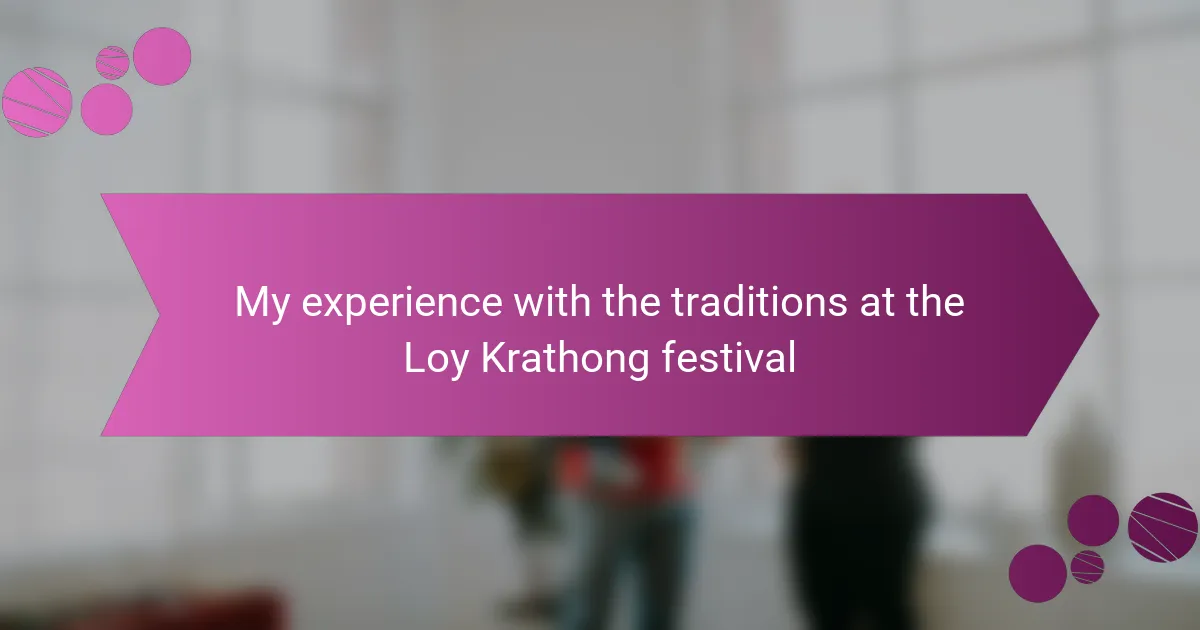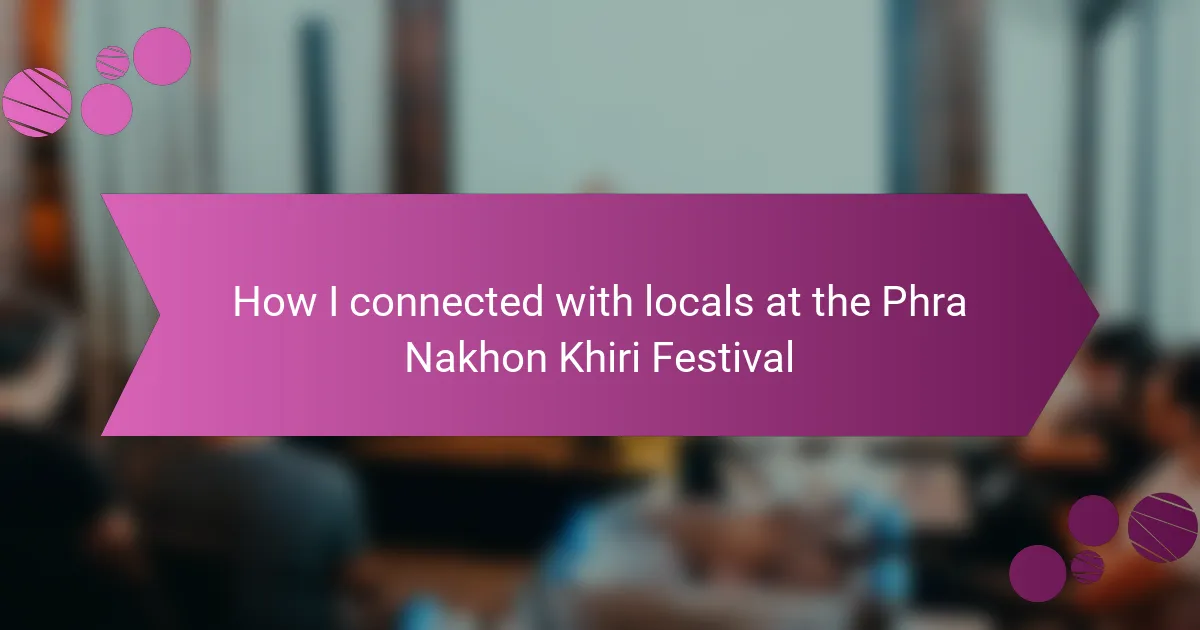Key takeaways
- Loy Krathong Festival, celebrated in Thailand, emphasizes gratitude, reflection, and community through the release of krathongs on water.
- Traditional Thai music, featuring instruments like the khim and ranat, enhances the festival atmosphere, fostering shared joy and cultural connection.
- The festival serves as a reminder of our environmental responsibilities and the importance of passing cultural traditions to future generations.
- Personal experiences during the festival evoke deep emotions, creating cherished memories and a sense of unity among participants.
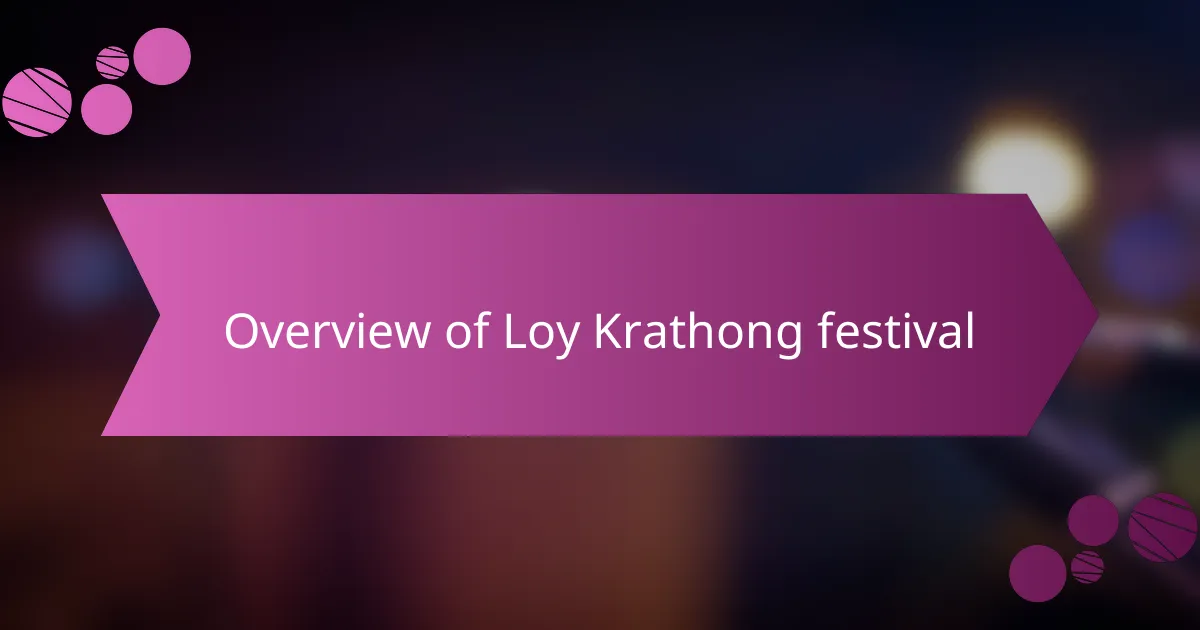
Overview of Loy Krathong Festival
Loy Krathong is a visually stunning festival celebrated annually in Thailand, usually falling in November during the full moon. The sight of countless floating lanterns shimmering on the water is something that can take your breath away. Have you ever wondered how it feels to release your own krathong to the river, filled with hopes and wishes?
As I participated in Loy Krathong for the first time, I was struck by the atmosphere. People gathered by rivers and lakes, their faces illuminated by the soft glow of lanterns. The sense of peace and community is palpable, as families and friends come together to honor the goddess of water. It’s a beautiful blend of reflection and celebration—what could be more meaningful than letting go of past troubles?
The festival also has deep-rooted traditions, like honoring the water spirits and expressing gratitude for the year’s blessings. Watching locals prepare delicate krathongs made from banana leaves, adorned with flowers and candles, takes you into a world rich with culture and reverence. Isn’t it incredible how such traditions help us connect not only with nature but also with each other?
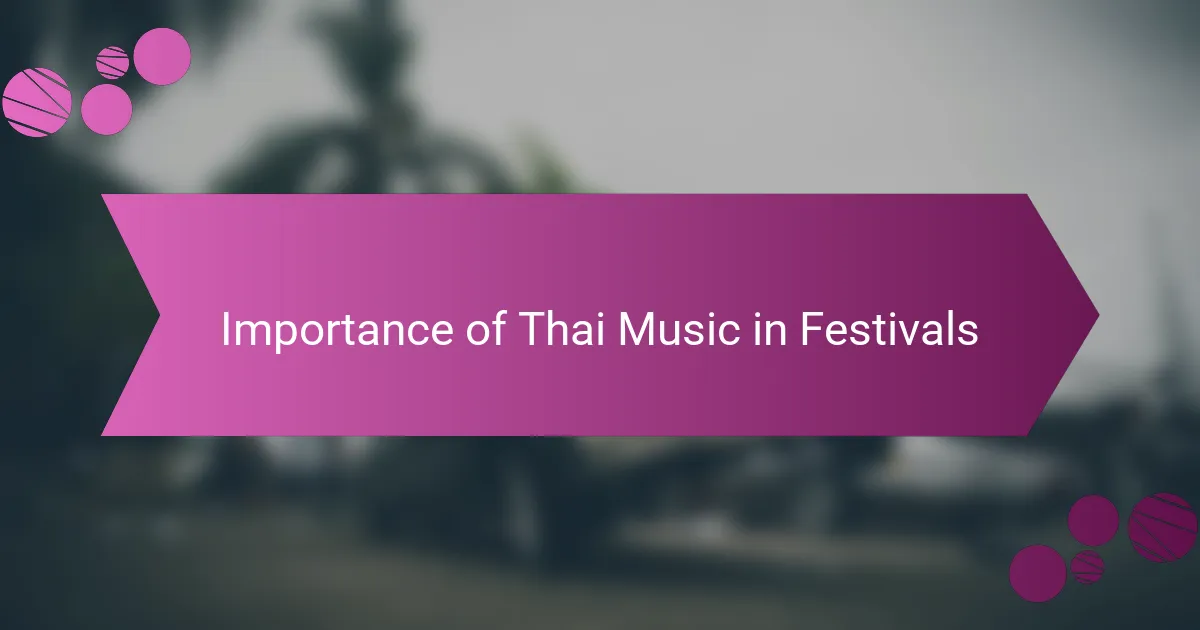
Importance of Thai Music in Festivals
Thai music plays a pivotal role in festivals, weaving a tapestry of emotions and cultural significance. During the Loy Krathong Festival, traditional melodies resonate through the air, enhancing the enchanting atmosphere. I remember swaying to the rhythmic beats while surrounded by vibrant performances—it felt like the music connected everyone, creating a shared sense of joy and reverence.
The songs often tell stories of love, nature, and [censured], reflecting the essence of Thai culture. Every note seems to evoke memories and feelings, transporting me back to moments shared with friends and family by the water’s edge. Have you ever experienced a song that brings back vivid memories from a special event? That’s the magic of music at festivals—it binds us to our past and enriches our celebrations.
Moreover, music serves as a form of communication, conveying emotions that words sometimes cannot express. As I watched dancers clad in traditional attire move gracefully, the accompanying music seemed to elevate their movements, making the entire scene come alive. It’s fascinating how these harmonious sounds enhance our understanding of the festivities and deepen our connections to Thai heritage.

Traditional Music Instruments Used
When I think of the Loy Krathong festival, the first thing that comes to mind is the captivating sound of traditional Thai music. Instruments like the khim, a stringed instrument, create a melodic and soothing atmosphere that perfectly complements the festival’s serene beauty. I remember sitting by the water, listening to the gentle strumming of the khim while watching the krathongs float away, feeling a deep connection to the culture.
Another significant instrument is the ranat, a traditional xylophone that adds a lively rhythm to the celebrations. I found myself tapping my feet to its upbeat tunes, which brought both joy and nostalgia. The combination of these instruments, along with the heartfelt songs performed during Loy Krathong, truly captures the essence of this beautiful festival.
Here’s a comparison of some traditional instruments featured during the festival:
| Instrument | Description |
|---|---|
| Khim | A stringed instrument that produces a soft, melodic sound, often played in ensembles. |
| Ranat | A xylophone with a vibrant sound that adds rhythm and energy to performances. |
| Traditional Drums | Provide a strong beat that enhances the festive atmosphere and encourages dance. |
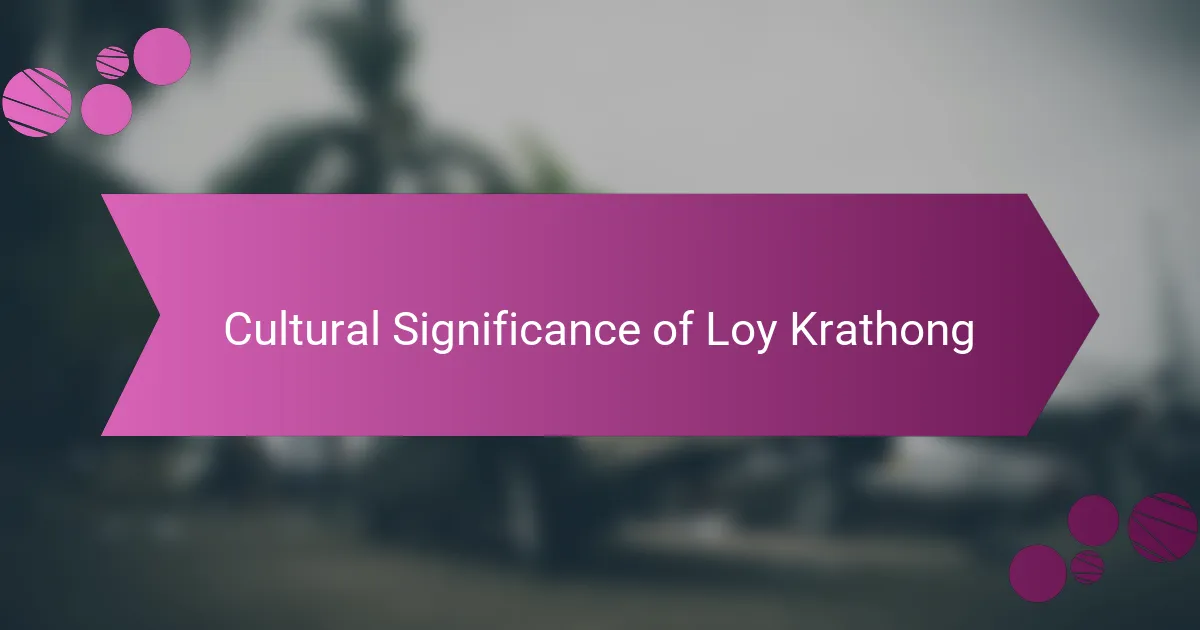
Cultural Significance of Loy Krathong
The cultural significance of Loy Krathong extends beyond the beautiful visuals to embody core values of gratitude and respect. As I prepared my krathong, I reflected on the meaning behind the act. It’s not just about letting go; it’s a symbolic gesture of thanking the goddess of water for her bounty and asking for forgiveness for any negative impact humans might have on nature. Can you imagine the weight of those emotions as your hopes sail on the water?
In my experience, the festival serves as a reminder of our connection to the environment and each other. Watching families gather, their joy evident as they release their krathongs, truly underscores the togetherness of the occasion. Each floating vessel carries wishes for the future, symbolizing collective hopes. Isn’t it beautiful how a simple act can unite people across generations and backgrounds?
Moreover, Loy Krathong emphasizes the importance of reflection. It invites us to pause and consider the past year—the challenges we overcame and the blessings we received. I often find myself lost in thought as I gaze at the flickering lights on the water, pondering the journey ahead. This reflective aspect not only enriches the festival but also encourages a deeper appreciation for our lives and the natural world around us.
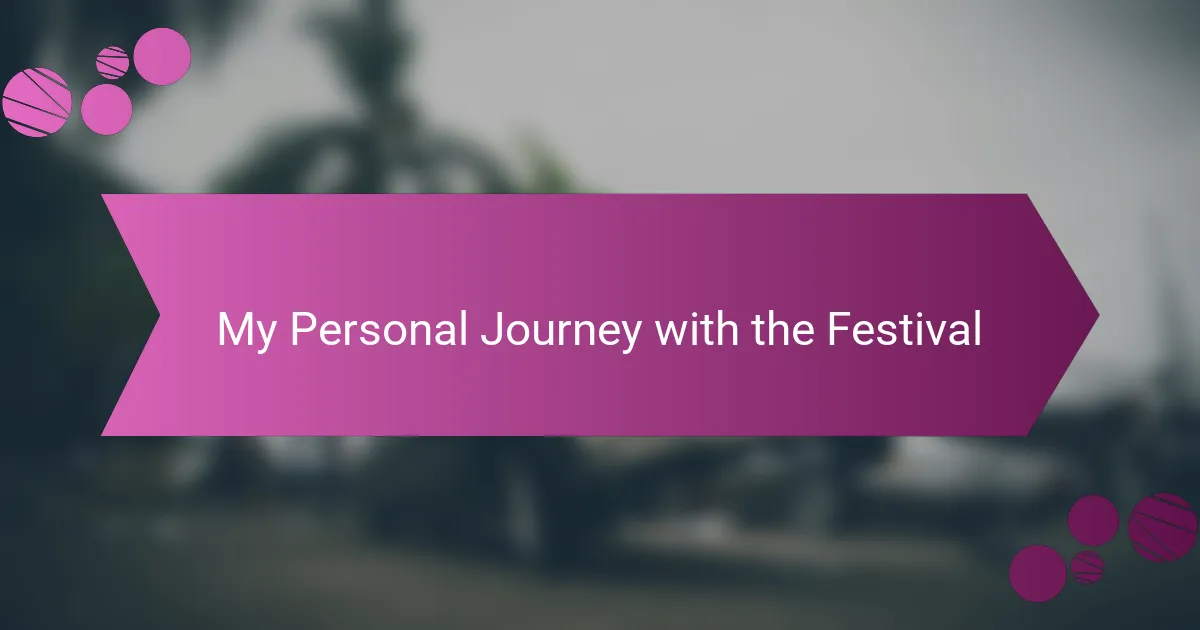
My Personal Journey with the Festival
As I looked out over the water during my first Loy Krathong experience, I felt an overwhelming sense of tranquility wash over me. In that moment, with my krathong gently floating away, I found myself lost in reflections of the past year. The warm glow of the lanterns mirrored my own hopes and dreams, creating a connection between my personal journey and the communal spirit all around me. Have you ever felt that kind of shared emotion at a celebration? It truly brings a unique depth to the festival.
While participating in the making of my krathong, I felt an exhilarating blend of excitement and reverence. Crafting it from banana leaves and flowers was almost meditative, as each layer represented a piece of my gratitude and aspirations. I recall laughing with friends while adding small candles, sharing stories of past festivals and what we hoped to release into the flow of the river. It’s incredible how a simple, yet profound act can turn into a cherished memory, connecting us with each other and our heritage.
Every year since, I’ve returned to the festival and reveled in its beauty while gaining a deeper understanding of its significance. Witnessing generations come together—parents teaching their children about the traditions—reminds me of the importance of passing down our cultural values. I often wonder, what future generations will add to this tapestry of togetherness and gratitude? Each celebration fills me with new insights, inspiring me to honor not just the festival but also the life lessons it offers.
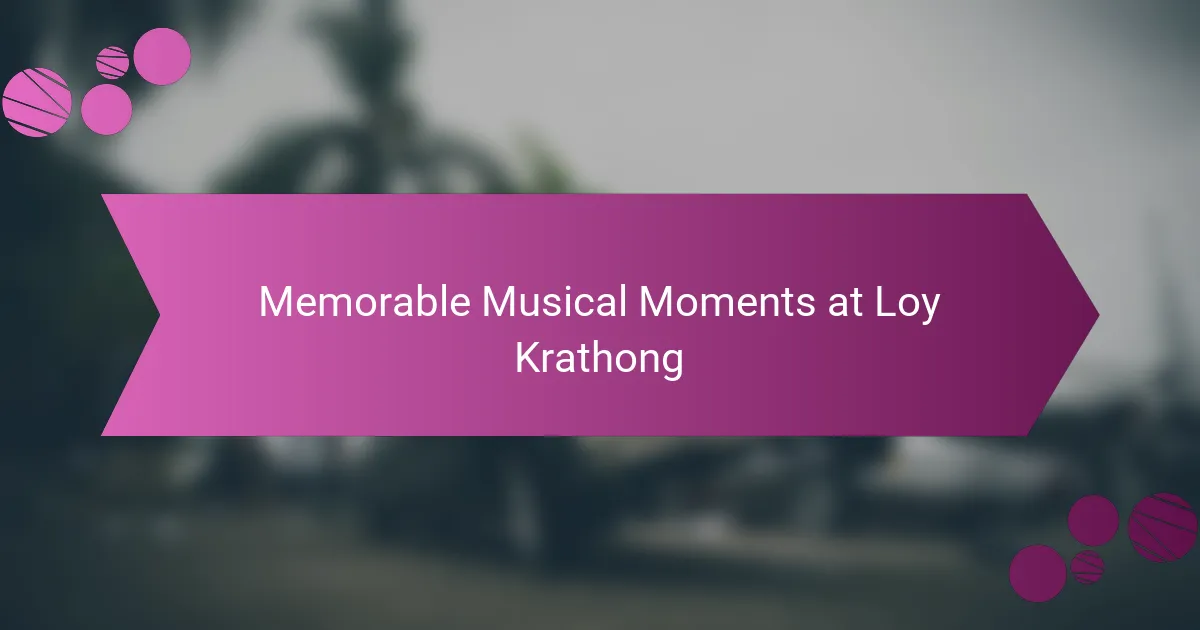
Memorable Musical Moments at Loy Krathong
The blend of music at Loy Krathong is truly unforgettable. I recall standing by the riverside, when the gentle sounds of the khim began to play, wrapping around me like a comforting embrace. It instantly transported me to a place where the worries of the world melted away, letting the serene beauty of the moment shine through. Have you ever felt a song resonate so deeply that it feels like a soundtrack to a special memory?
Throughout the evening, engaging performances filled the air with captivating rhythms. I watched a traditional dance unfold, where each movement seemed to harmonize perfectly with the vibrant sounds of the ranat. The dancers’ graceful motions paired with the lively beats made me want to join in and celebrate with them. It’s fascinating how music can elevate moments like these, connecting people in joy and reverence, even if we are strangers.
What struck me most was the sense of unity fostered by the music. People gathered closer, sharing in the melody and clapping along. I found myself exchanging smiles and laughter with those around me, all of us swept up in the spirit of the festival. Isn’t it amazing how a shared musical experience can create bonds in the moment? In that magical atmosphere, it felt like we were all part of something much larger than ourselves, celebrating together under the glittering night sky.
